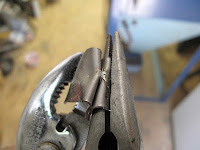The other day my neighbor, Galen, stopped by to pick up some embroidery. While his family patiently waited I showed him the progress on the various airplane projects and my efforts to make gas spot weld for the manifolds.. He said they had just stopped at Harbor Freight and saw a spot welder on sale. I've generally avoided Harbor Freight because a fair amount of the tools they sell are just too cheesy for words. At the same time they can have some cheap deals which I'll admit has a certain appeal to me. The welder was on sale for $179 so we drove the 40 miles to the nearest one and bought the welder. My general opinion of their tools hasn't changed as a result, but I couldn't find anything close on line and I don't have a lot of welds to make.
I bought the 230 v model, same price as 120 v model, since I have the attic wired for it. It doesn't come with a plug so I stopped at Lowe's and got one to match my outlets. The rest of the assembly was simple. It's all metric, think Chinese, and you need a 6 mm Allen wrench to install the copper Prongs.
The idea is you adjust the position of the top prong so you get the pressure you want when the handle is closed against the stop bolt, below the back of the handle. Then you flip the switch under the handle until the weld is done, as soon as you see red. Spot weld spatter, were eye protection. The problem I had was that the top prong either is the wrong one or they've started just using the bottom prong for both. I didn't want to wait for their help line to be open to solve the problem so I modified the top prong.
The bottom prong is bent with a 90 degree bend. The instruction sheet shows the top prong bent 90 degrees at the end but 2 other bends so that the ends are coaxial when closed for welding. You want both electrodes square to the metal you're welding for good current flow. Also, I could not get the electrodes to close and the handle to close to the stop. The bends solved the problems and it welds great.
One of the things we did at AC Spark Plug to control spot welds, and assure they always formed, was to put a bump on one of the parts being welded. It controls where the weld forms, that you have metal to metal contact, creates a hot spot to start the weld, and allows you to position the weld with very blunt electrodes which last longer and are easier to make. I used my Whitney punch with a 3/32" punch and 5/32" die to make these 2 samples on the right. You want a bump of about 1/2 to 1 material thickness. Anywhere between these 2 samples will work fine. You also want just enough pressure on the electrodes to get good current flow, not to mash into the weld puddle.
A good weld should tear out of the steel, not separate. I finally gave up trying to tear my samples apart. The welds are very strong.




No comments:
Post a Comment